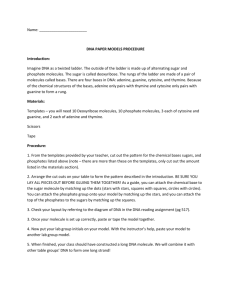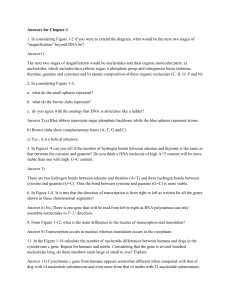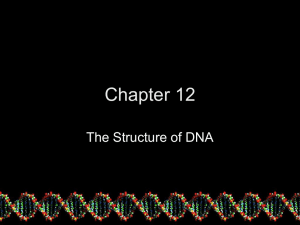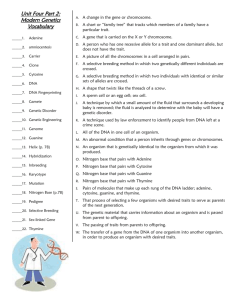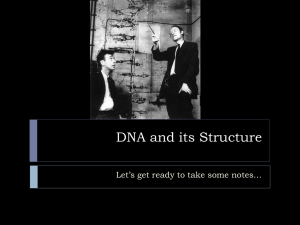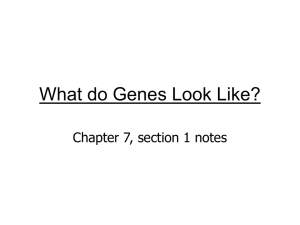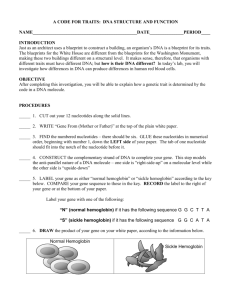DNA STRUCTURE LAB
advertisement
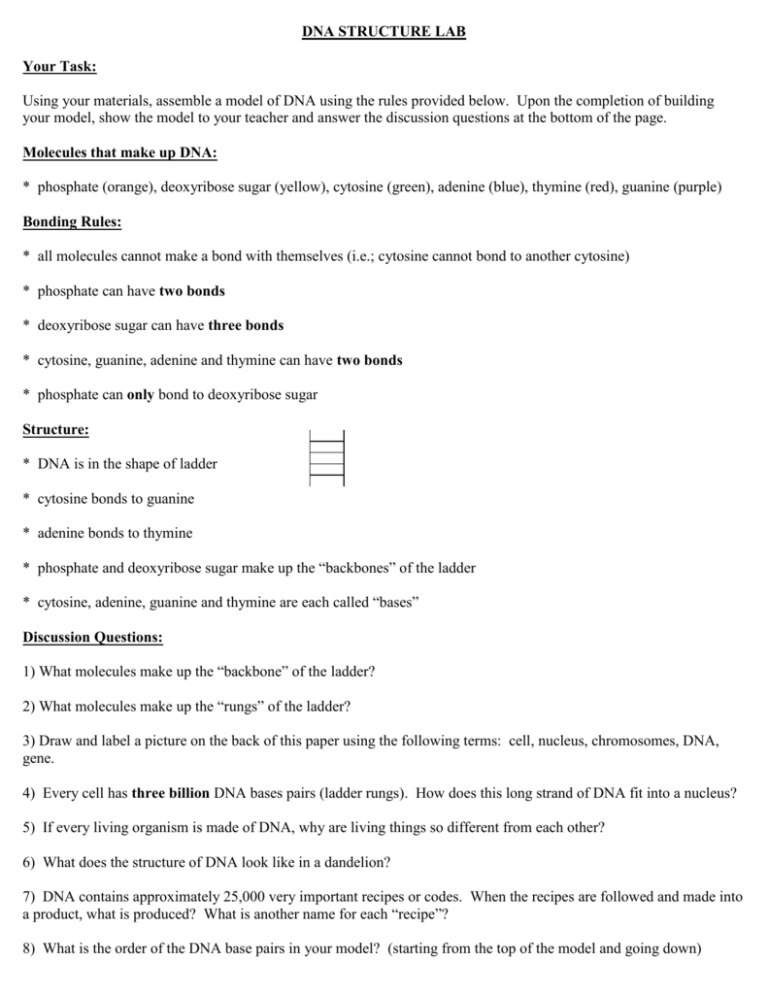
DNA STRUCTURE LAB Your Task: Using your materials, assemble a model of DNA using the rules provided below. Upon the completion of building your model, show the model to your teacher and answer the discussion questions at the bottom of the page. Molecules that make up DNA: * phosphate (orange), deoxyribose sugar (yellow), cytosine (green), adenine (blue), thymine (red), guanine (purple) Bonding Rules: * all molecules cannot make a bond with themselves (i.e.; cytosine cannot bond to another cytosine) * phosphate can have two bonds * deoxyribose sugar can have three bonds * cytosine, guanine, adenine and thymine can have two bonds * phosphate can only bond to deoxyribose sugar Structure: * DNA is in the shape of ladder * cytosine bonds to guanine * adenine bonds to thymine * phosphate and deoxyribose sugar make up the “backbones” of the ladder * cytosine, adenine, guanine and thymine are each called “bases” Discussion Questions: 1) What molecules make up the “backbone” of the ladder? 2) What molecules make up the “rungs” of the ladder? 3) Draw and label a picture on the back of this paper using the following terms: cell, nucleus, chromosomes, DNA, gene. 4) Every cell has three billion DNA bases pairs (ladder rungs). How does this long strand of DNA fit into a nucleus? 5) If every living organism is made of DNA, why are living things so different from each other? 6) What does the structure of DNA look like in a dandelion? 7) DNA contains approximately 25,000 very important recipes or codes. When the recipes are followed and made into a product, what is produced? What is another name for each “recipe”? 8) What is the order of the DNA base pairs in your model? (starting from the top of the model and going down) DNA STRUCTURE LAB Your Task: Using your materials, assemble a model of DNA using the rules provided below. Upon the completion of building your model, show the model to your teacher and answer the discussion questions at the bottom of the page. Molecules that make up DNA: * phosphate (orange), deoxyribose sugar (yellow), cytosine (green), adenine (blue), thymine (red), guanine (purple) Bonding Rules: * all molecules cannot make a bond with themselves (i.e.; cytosine cannot bond to another cytosine) * phosphate can have two bonds * deoxyribose sugar can have three bonds * cytosine, guanine, adenine and thymine can have two bonds * phosphate can only bond to deoxyribose sugar Structure: * DNA is in the shape of ladder * cytosine bonds to guanine * adenine bonds to thymine * phosphate and deoxyribose sugar make up the “backbones” of the ladder * cytosine, adenine, guanine and thymine are each called “bases” Discussion Questions: 1) What molecules make up the “backbone” of the ladder? 2) What molecules make up the “rungs” of the ladder? 3) Draw and label a picture on the back of this paper using the following terms: cell, nucleus, chromosomes, DNA, gene. 4) Every cell has three billion DNA bases pairs (ladder rungs). How does this long strand of DNA fit into a nucleus? 5) If every living organism is made of DNA, why are living things so different from each other? 6) What does the structure of DNA look like in a dandelion? 7) DNA contains approximately 25,000 very important recipes or codes. When the recipes are followed and made into a product, what is produced? What is another name for each “recipe”? 8) What is the order of the DNA base pairs in your model? (starting from the top of the model and going down)

